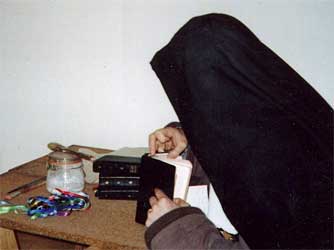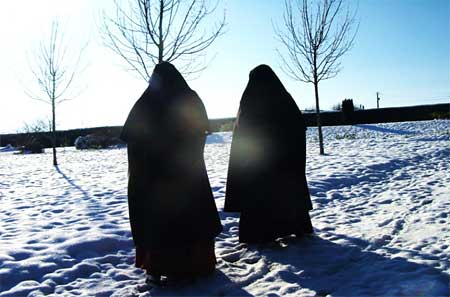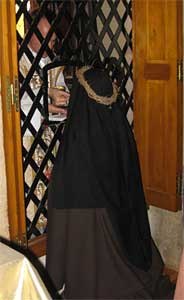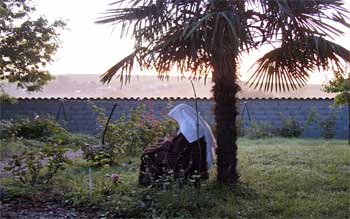

![]()
![]()
|
Religious
Communities for Women
“I will allure the soul and lead her into solitude, and there, will speak to her heart” (Osee II, 14). The Capuchin Poor Clares are contemplative religious who live in an atmosphere of silence, as God, whom they seek, is not found in turmoil, and to His Divine Majesty, no praise rises up more appropriately than in silence. They have responded to a calling which has separated them from the world. Living within an enclosure, they devote themselves to prayer and sacrifice. Living hidden, “behind the grill”; forgotten, they forget no-one, as their mission is to praise God in the name of all humanity. They present to Him the misery of the world, that He may send His grace and transforming light. Following the words of their mother and foundress, they are “the cooperatives of God, the coadjutrices of Jesus Christ in the sublime work of the sanctification of souls; the support and strength of the weak and suffering members of the Mystical Body”. As stated by Pope Pius XI, those who, by their vocation, devote themselves to prayer and penance, contribute more to the extension of the Church and the salvation of the human race than those who work in the field of the Father by exterior works. And Pope Pius XII called contemplatives “the most illustrious part of his flock”.
Clare was eighteen years of age when, in 1212, Saint Francis came to preach the Lenten course in the church of Saint George in Assisi. The inspired words of the Poverello (the poor little man) kindled a flame in the heart of Clare. She sought him out secretly and begged him to help her that she might too live “after the manner of the holy Gospel”.
On Palm Sunday, Clare, arrayed in all her finery, attended High Mass at the cathedral... This was to be the last time that the world beheld her. That night, she secretly left her father’s house, at the advice of St. Francis, accompanied by her aunt and another companion, and proceeded to the chapel of the Portiuncula (the first chapel occupied by St. Francis) where St. Francis, having cut off her hair, clothed her in a coarse, penitential tunic, with a white cord and a thick veil. This was the way in which the mother and foundress of the Poor Clares entered religion, vowing herself forever to the service of Jesus Christ. For a short while St. Francis placed Clare within a Benedictine convent. Soon, Clare’s younger sister Catherine (who would become St. Agnes) joined her, followed by other souls fleeing the world (as did later her mother and other sister). Before long, St. Francis had obtained a rude dwelling which adjoined St. Damien’s chapel. Thus was founded the first community of ‘Poor Ladies’ or ‘Poor Clares’, as this Second Franciscan Order came to be known.
During her life, St. Clare had valiantly defended her Order’s essential Franciscan characteristic - devotion to holy poverty - to be stripped of all possessions so as to possess God alone. Holding Jesus as her unique treasure, she embraced this virtue in a manner absolute. Modelling her life on His, she devoutly imitated His privations, hardships and detachment from all things under heaven, which drew even the admiration of the Sovereign Pontiff. After petitioning Holy See, she obtained from Innocent III “the privilege of Most High Poverty”, which allowed the Poor Clares to not own any property (other than their convent) and to receive no fixed income. Thus, they could live completely abandoned to the hand of Divine Providence - depending on the alms and charity of the faithful, for whom they offered daily prayers and penance. Two days before the death of St. Clare, Innocent IV confirmed her own Rule which she had left to her daughters.
Other convents were founded in imitation of St. Damien’s. Over time however, many departed from their original Rule and a reform was needed to return to the Order’s primitive ideal of High Poverty. In France, God raised up Saint Colette of Corbie (XVth century), who was appointed by Benedict XIII to reform the whole of the Order. She founded 17 new convents as well as reforming many others, to which, in addition to the Rule of St. Clare, she gave her own specific Constitutions - which explained and clarified certain points of the Rule. (These were confirmed by Pius II.) This was the origin of the ‘Colettine’ Poor Clares. In Italy, in 1560, the Venerable Mother Mary-Lawrence Longo founded a convent of Franciscan nuns whose direction was entrusted to the Capuchin friars (one of the three branches of the Franciscan family). The Capuchins instructed the religious to follow the primitive Rule of St. Clare, along with Colettine Constitutions - which the Capuchins had adapted - thus forming the first ‘Capuchin’ Poor Clare community. One characteristic of the Capuchin branch is that their ‘Most High Poverty’ has been extended to include not even owning their own convent.
The Vatican II Council resulted in vast reforms to the Capuchin Order’s Constitutions, rendering it impossible for religious to continue living according to their Rule and the ideals laid down by St. Francis and St. Clare. Consequently, Rev. Father Eugene (Capuchin from the Province of Lyon, France, 1904-1990) parted from his community, and in 1972 founded a small community of friars in Verjon (Ain, France). As the numbers of this new religious family increased, Providence placed them amongst the vineyards of Morgon (Rhône), at what was to be the Friary of St. Francis. In response to interest which had been shown towards the Poor Clare vocation, in 1989 the Capuchin friars acquired a modest property which they named the Portiuncula, close to the friary, with the view to accommodating the first Poor Clare aspirants. In 1990, the first five aspirants presented themselves to the Father Guardian, who, for their initial formation sent them to a traditional community of nuns for two years. The time having passed, the postulants returned to Morgon, where they were lodged temporarily at the Portiuncula, along with Sister Mary-Isabella of Jesus Crucified (Colettine Poor Clare from Normandy, 1913-2001) who, after having left community due to modernism, found her way to Morgon where she was happy to join this new foundation. After a novena to Rev. Father Viktricius in January 1993 (Capuchin of the Province of Bavaria, died in the odour of sanctity, 1842-1924) a vine grower’s house, just ten minutes by foot from the friary, became available and was acquired. Thanks to the friars’ devotion and their benefactors’ generosity, the house was transformed into the Convent of Saint Clare, and in August 1993, the Poor Clares of Morgon left the Portiuncula to settle there. The solemn benediction of the convent and cloister took place in 1995.
The law of the sisters of St. Clare is the Gospel, prayer is their life and being together is their joy, though none of these can be reached without effort and all the self-denying that Jesus asks from his followers. Their common vocation, prayer and ideal is real simplicity of heart and the love which goes beyond all differences of temperament, culture, race and age, linking them in Christ. Always ready to help one another, they gather daily for a half-hour recreation where they exchange fraternally their ideas and experiences, and enjoy, in simplicity, and at times in laughter, music and song, the grace of being together. The Poor Clares observe a strict ‘grand silence’ for half an hour each afternoon and from 7:30pm until after Mass the following morning. The remainder of the time is protected by an ‘evangelical silence’ which banishes useless conversation and imposes speaking in a low voice. There is an atmosphere of solitude, each nun having a cell at her disposal, though their life is communal and familial. Charity is given free rein, for as St. Clare says, echoing St. Francis, “If a mother loves and nourishes her son according to the flesh, all the more should each of you love and nourish your sister according to the spirit”. In this atmosphere one’s personality blossoms freely. The Franciscan Rule, if it tends to making every sister a saint, loves them, however, as all very different, as St. Francis was very different from his shy “little lamb” Brother Leo. They enjoy a certain amount of free time to use as best suits them personally, all, of course, under obedience - the principal requirement of the religious life.
The centre and summit of the Poor Clare’s day is the Mass, celebrated each morning at the convent by a Capuchin Father. Here, at the foot of the Cross, in union with Our Lady, the sisters offer themselves with the Divine Victim, collecting up His Precious Blood for the purification and sanctification of themselves and of all mankind. Nourished by this heavenly mystery, they draw the strength, light and zeal needed in their day to day combats over self and in their acquisition of the spirit of Christ. Two hours a day are spent before the Blessed Sacrament exposed, where, in the silence of her soul, the Poor Clare adores and unites herself to the desires and dispositions of the Heart of Jesus. Above all, she seeks to respond to His sorrowful call, echoed from Calvary, “I looked for one who would console me, but found no-one” (PS 68), hence she returns love for Love, loving Him for all those who love Him not. Devotions and prayers said in common include the rosary, litanies, and the stations of the cross. No particular form of mental prayer is imposed and spiritual reading is included in the nuns’ daily time-table, books for which can be chosen from the convent’s library.
While at work, the sisters keep their glance turned towards the blessed abode of Nazareth endeavouring to continue the Holy Family’s life of silence, charity and the practice of the humble virtues of each day. Like the house of Nazareth, they desire their convent to be a sanctuary of the divine presence, a lamp burning perpetually for God, an oasis for Our Lord – where He finds Himself honoured and His father glorified.
Aspirants should have a great desire to develop a life of prayer and union with God. “She needs a great heart, large enough to embrace the needs of the whole world; delicate enough to live joyfully and peacefully with all her sisters; strong enough to follow Christ on the way of the Cross; and so open to His grace that the Virgin Mary’s ‘Fiat’ may always find an echo in her. Then she will know that it is in losing one’s life, that true life is found; that the deepest joy comes from union with the living God; and that spiritual motherhood is given to those for whom Christ is all”.
Generous souls, listen to the words of St. Clare: “Our labour here below lasts but a while, while the reward is eternal... Don’t let yourself be taken in by the false appearances of a deceitful world” (Letter to Ermentrude). Interested persons may write to the Mother Superior. A guest room is attached to the convent where aspirants may stay, though reservations must be made in advance.
FRUITS OF THE SERAPHIC ORDER The Seraphic Order (The Franciscan Order) is said to count more saints than any other Order (over 400 saints and blessed). Here are a few of the fruits harvested from the Capuchin Poor Clare branch:
Among the Capuchin Friars Minor:
|




























